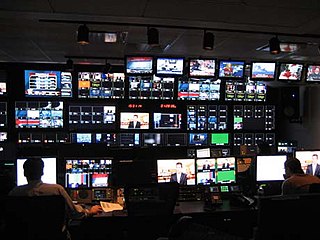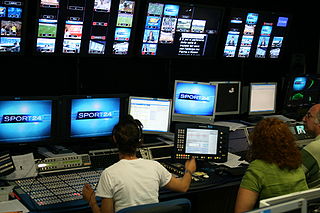
Broadcasting is the distribution of audio or video content to a dispersed audience via any electronic mass communications medium, but typically one using the electromagnetic spectrum, in a one-to-many model. Broadcasting began with AM radio, which came into popular use around 1920 with the spread of vacuum tube radio transmitters and receivers. Before this, most implementations of electronic communication were one-to-one, with the message intended for a single recipient. The term broadcasting evolved from its use as the agricultural method of sowing seeds in a field by casting them broadly about. It was later adopted for describing the widespread distribution of information by printed materials or by telegraph. Examples applying it to "one-to-many" radio transmissions of an individual station to multiple listeners appeared as early as 1898.

The Society of Broadcast Engineers (SBE) is a professional organization for engineers in broadcast radio and television. The SBE also offers certification in various radio frequency and video and audio technology areas for its members.

BBC Television is a service of the BBC. The corporation has operated a public broadcast television service in the United Kingdom, under the terms of a royal charter, since 1927. It produced television programmes from its own studios from 1932, although the start of its regular service of television broadcasts is dated to 2 November 1936.

A professional video camera is a high-end device for creating electronic moving images. Originally developed for use in television studios or with outside broadcast trucks, they are now also used for music videos, direct-to-video movies, corporate and educational videos, wedding videos, among other uses. Since the 2000s, most professional video cameras are digital.
An automatic transmission system (ATS) is an automated system designed to keep a broadcast radio or television station's transmitter and antenna system running without direct human oversight or attention for long periods. Such systems are occasionally referred to as automated transmission systems to avoid confusion with the automatic transmission of an automobile.
Broadcast engineering or radio engineering is the field of electrical engineering, and now to some extent computer engineering and information technology, which deals with radio and television broadcasting. Audio engineering and RF engineering are also essential parts of broadcast engineering, being their own subsets of electrical engineering.

Master control is the technical hub of a broadcast operation common among most over-the-air television stations and television networks. It is distinct from a production control room (PCR) in television studios where the activities such as switching from camera to camera are coordinated. A transmission control room (TCR) is usually smaller in size and is a scaled down version of centralcasting.

A television studio, also called a television production studio, is an installation room in which video productions take place, either for the production of live television and its recording onto video tape or other media such as SSDs, or for the acquisition of raw footage for post-production. The design of a studio is similar to, and derived from, movie studios, with a few amendments for the special requirements of television production. A professional television studio generally has several rooms, which are kept separate for noise and practicality reasons. These rooms are connected via 'talkback' or an intercom, and personnel will be divided among these workplaces.

The production control room (PCR) or studio control room (SCR) is the place in a television studio in which the composition of the outgoing program takes place.

Outside broadcasting (OB) is the electronic field production (EFP) of television or radio programmes from a mobile remote broadcast television studio. Professional video camera and microphone signals come into the production truck for processing, recording and possibly transmission.
Television crew positions are derived from those of film crew, but with several differences.
The Technology and Engineering Emmy Awards, or Technology and Engineering Emmys, are one of two sets of Emmy Awards that are presented for outstanding achievement in engineering development in the television industry. The Technology and Engineering Emmy Awards are presented by the National Academy of Television Arts and Sciences (NATAS), while the separate Primetime Engineering Emmy Awards are given by its sister organization the Academy of Television Arts & Sciences (ATAS).
A television station is a set of equipment managed by a business, organisation or other entity such as an amateur television (ATV) operator, that transmits video content and audio content via radio waves directly from a transmitter on the earth's surface to any number of tuned receivers simultaneously.

Radiodiffusion-Télévision Française was the French national public broadcaster television organization established on 9 February 1949 to replace the post-war "Radiodiffusion Française" (RDF), which had been founded on 23 March 1945 to replace Radiodiffusion Nationale (RN), created on 29 July 1939. It was replaced in its turn, on 26 June 1964, by the notionally less-strictly government controlled Office de Radiodiffusion Télévision Française (ORTF), which itself lasted until the end of 1974.
WRNY was a New York City AM radio station that began operating in 1925. It was started by Hugo Gernsback's Experimenter Publishing Company to promote his radio and science magazines. Starting in August 1928, WRNY was one of the first stations to make regularly scheduled experimental television broadcasts. Experimenter Publishing went bankrupt in early 1929 and the station was purchased by the Curtiss Aeroplane and Motor Company to promote aviation. WRNY was deleted in 1934, as part of a consolidation on its shared frequency by surviving station WHN.

In broadcast facilities and television studios, a central apparatus room, central machine room, or central equipment room (CER), or central technical area (CTA), or rack room is where shared equipment common to all technical areas is located. Some broadcast facilities have several of these rooms. It should be air-conditioned, however low-noise specifications such as acoustical treatments are optional. Equipment is connected either directly with an attached foldout monitor, keyboard and mouse or remotely via KVM switch, SSH, VNC, RS-232 or remote desktop.
Certified television operator (CTO) is a title granted to an individual that successfully passes the examination requirements of the certification in the United States. The certification is regulated by the Society of Broadcast Engineers (SBE). The certification title is protected by copyright laws. Individuals who use the title without consent from the Society of Broadcast Engineers could face legal action.
Certified Broadcast Television Engineer (CBTE) is a title granted to an individual who successfully meets the experience and examination requirements of the certification. The certification is regulated by the Society of Broadcast Engineers (SBE). The CBTE title is protected by copyright laws. Individuals who use the title without consent from the Society of Broadcast Engineers could face legal action.

A television production truck or OB van is a small mobile production control room to allow filming of events and video production at locations outside a regular television studio. They are used for remote broadcasts, outside broadcasting (OB), and electronic field production (EFP). Some require a crew of as many as 30 people, with additional trucks for additional equipment as well as a satellite truck, which transmits video back to the studio by sending it up through a communications satellite using a satellite dish, which then transmits it back down to the studio. Alternatively, some production trucks include a satellite transmitter and satellite dish for this purpose in a single truck body to save space, time and cost.
Rhodesia Television (RTV) was a live-broadcast, television station operating in Southern Rhodesia (now Zimbabwe) as a private company. It was established on the 14th of November, 1960, first in Salisbury (now Harare), with transmissions in Bulawayo beginning seven months later. It was only the fourth TV service in Africa after Algeria, Nigeria and Egypt, and the first such service in southern Africa, since South Africa did not introduce television until 1976.














